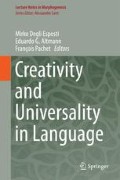Abstract
In this paper we address the issue of creativity and style computation from a natural language processing perspective. We introduce a computational framework for creativity analysis with two approaches, one agnostic, based on clustering, and one knowlegde-based, that exploits supervised learning and feature selection. While the agnostic approach can reveal the uniqueness of authors in a meaningful context, the knowledge-based approach can be exploited to extract the culturally relevant features of works and to predict social acceptance. In both the approaches, it is required a great effort to define symbols to represent meaningful cues in creativity and style.
Access this chapter
Tax calculation will be finalised at checkout
Purchases are for personal use only
References
Csikszentmihalyi, M.: Society, Culture, and Person: A Systems View of Creativity. Cambridge University Press, Cambridge (1988)
Csikszentmihalyi, M.: Flow and the Psychology of Discovery and Invention. HarperPerennial, New York (1997)
Kraft, U.: Unleashing creativity. Sci. Am. Mind 16(1), 16–23 (2005)
Guilford, J.P.: Intelligence, Creativity, and Their Educational Implications. RR Knapp, San Diego (1968)
Torrance, E.P.: The nature of creativity as manifest in its testing. The Nature of Creativity pp. 43–75 (1988)
Piffer, D.: Can creativity be measured? an attempt to clarify the notion of creativity and general directions for future research. Think. Skills Creat. 7(3), 258–264 (2012). doi:10.1016/j.tsc.2012.04.009
Kaufman, J.C., Lee, J., Baer, J., Lee, S.: Captions, consistency, creativity, and the consensual assessment technique: new evidence of reliability. Think. Skills Creat. 2(2), 96–106 (2007)
Carson, S.H., Peterson, J.B., Higgins, D.M.: Reliability, validity, and factor structure of the creative achievement questionnaire. Creat. Res. J. 17(1), 37–50 (2005)
Liu, Y.T.: Creativity or novelty?: cognitive-computational versus social-cultural. Des. Stud. 21(3), 261–276 (2000)
Saunders, R., Gero, J.S.: Artificial creativity: A synthetic approach to the study of creative behaviour. Computational and Cognitive Models of Creative Design V, Key Centre of Design Computing and Cognition, pp. 113–139. University of Sydney, Sydney (2001)
Wiggins, G.: Categorising creative systems. In: Proceedings of Third (IJCAI) Workshop on Creative Systems: Approaches to Creativity in Artificial Intelligence and Cognitive Science. Citeseer (2003)
Barbieri, G., Pachet, F., Roy, P., Degli Esposti, M.: Markov constraints for generating lyrics with style. In: ECAI, pp. 115–120 (2012)
Runco, M.A., Nemiro, J., Walberg, H.J.: Personal explicit theories of creativity. J. Creat. Behav. 32(1), 1–17 (1998). doi:10.1002/j.2162-6057.1998.tb00803.x
Boden, M.A.: Creativity: a framework for research. Behav. Brain Sci. 17(03), 558–570 (1994)
Pribram, K.H.: Brain and the creative act. Encycl. Creat. 2, 213–217 (1999)
Mainemelis, C.: Stealing fire: creative deviance in the evolution of new ideas. Acad. Manag. Rev. 35(4), 558–578 (2010)
Runco, M.A.: Creativity: Theories and Themes: Research, Development, and Practice. Academic Press (2010)
Averill, J.R.: Creativity in the domain of emotion. Handbook of Cognition and Emotion, pp. 765–782 (1999)
Grira, N., Crucianu, M., Boujemaa, N.: Unsupervised and semi-supervised clustering: a brief survey. A Review of Machine Learning Techniques for Processing Multimedia Content, p. 11 (2004)
Jain, A.K.: Data clustering: 50 years beyond k-means. Pattern Recognit. Lett. 31(8), 651–666 (2010)
Kotsiantis, S.B.: Supervised machine learning: a review of classification techniques. Informatica (03505596) 31(3) (2007)
Molina, L.C., Belanche, L., Nebot, À.: Feature selection algorithms: a survey and experimental evaluation. In: IEEE International Conference on Data Mining, pp. 306–313. IEEE (2002)
Salappa, A., Doumpos, M., Zopounidis, C.: Feature selection algorithms in classification problems: an experimental evaluation. Optim. Methods Softw. 22(1), 199–212 (2007)
Mihalcea, R., Strapparava, C.: Lyrics, music, and emotions. In: Proceedings of the 2012 Joint Conference on Empirical Methods in Natural Language Processing and Computational Natural Language Learning, pp. 590–599. Association for Computational Linguistics (2012)
Witten, I.H., Frank, E., Hall, M.A.: Data Mining: Practical Machine Learning Tools and Techniques, 3rd edn. Morgan Kaufmann, Burlington, MA (2011)
Shevade, S.K., Keerthi, S.S., Bhattacharyya, C., Murthy, K.R.K.: Improvements to the smo algorithm for svm regression. IEEE Trans. Neural Netw. 11(5), 1188–1193 (2000)
Hall, M.A., Smith, L.A.: Practical Feature Subset Selection for Machine Learning. Springer, Berlin(1998)
Author information
Authors and Affiliations
Corresponding author
Editor information
Editors and Affiliations
Rights and permissions
Copyright information
© 2016 Springer International Publishing Switzerland
About this chapter
Cite this chapter
Celli, F. (2016). Computational Approaches to the Analysis of Human Creativity. In: Degli Esposti, M., Altmann, E., Pachet, F. (eds) Creativity and Universality in Language. Lecture Notes in Morphogenesis. Springer, Cham. https://doi.org/10.1007/978-3-319-24403-7_12
Download citation
DOI: https://doi.org/10.1007/978-3-319-24403-7_12
Published:
Publisher Name: Springer, Cham
Print ISBN: 978-3-319-24401-3
Online ISBN: 978-3-319-24403-7
eBook Packages: Social SciencesSocial Sciences (R0)

